engine Acura Integra 2000 Hatchback Service Manual
[x] Cancel search | Manufacturer: ACURA, Model Year: 2000, Model line: Integra, Model: Acura Integra 2000Pages: 279, PDF Size: 3.57 MB
Page 176 of 279
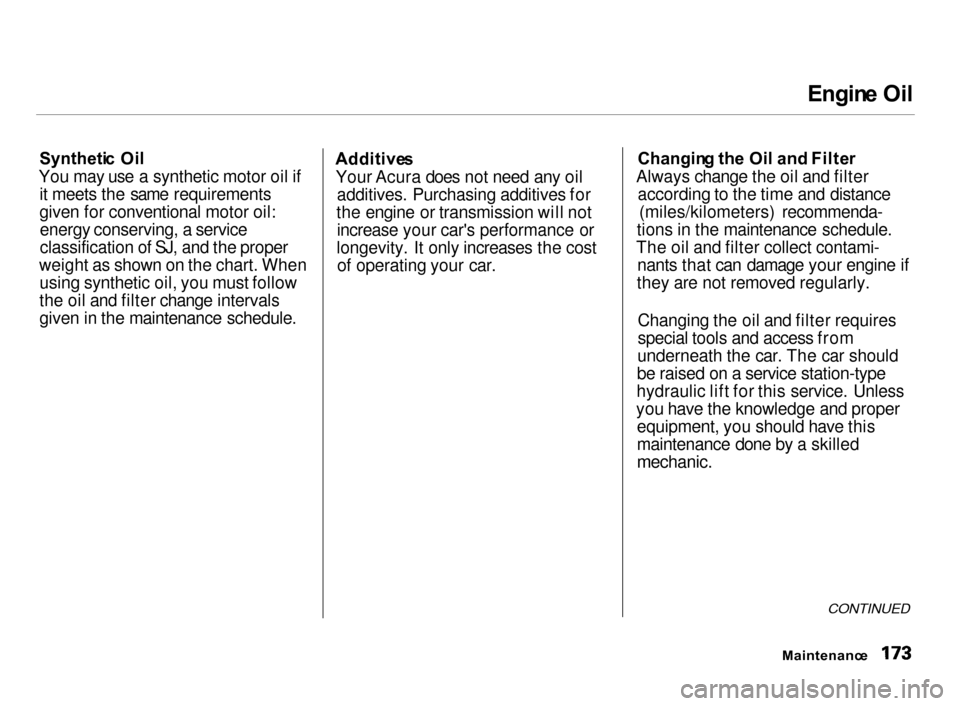
Engin
e Oi l
Syntheti c Oi l
You may use a synthetic motor oil if it meets the same requirements
given for conventional motor oil:energy conserving, a service
classification of SJ, and the proper
weight as shown on the chart. When using synthetic oil, you must follow
the oil and filter change intervals
given in the maintenance schedule. Additive
s
Your Acura does not need any oil additives. Purchasing additives for
the engine or transmission will not increase your car's performance or
longevity. It only increases the cost of operating your car. Changin
g th e Oi l and Filte r
Always change the oil and filter according to the time and distance(miles/kilometers) recommenda-
tions in the maintenance schedule.
The oil and filter collect contami- nants that can damage your engine if
they are not removed regularly.
Changing the oil and filter requires
special tools and access from
underneath the car. The car should
be raised on a service station-type
hydraulic lift for this service. Unless
you have the knowledge and proper equipment, you should have this
maintenance done by a skilled
mechanic.
CONTINUED
Maintenanc e
Page 177 of 279
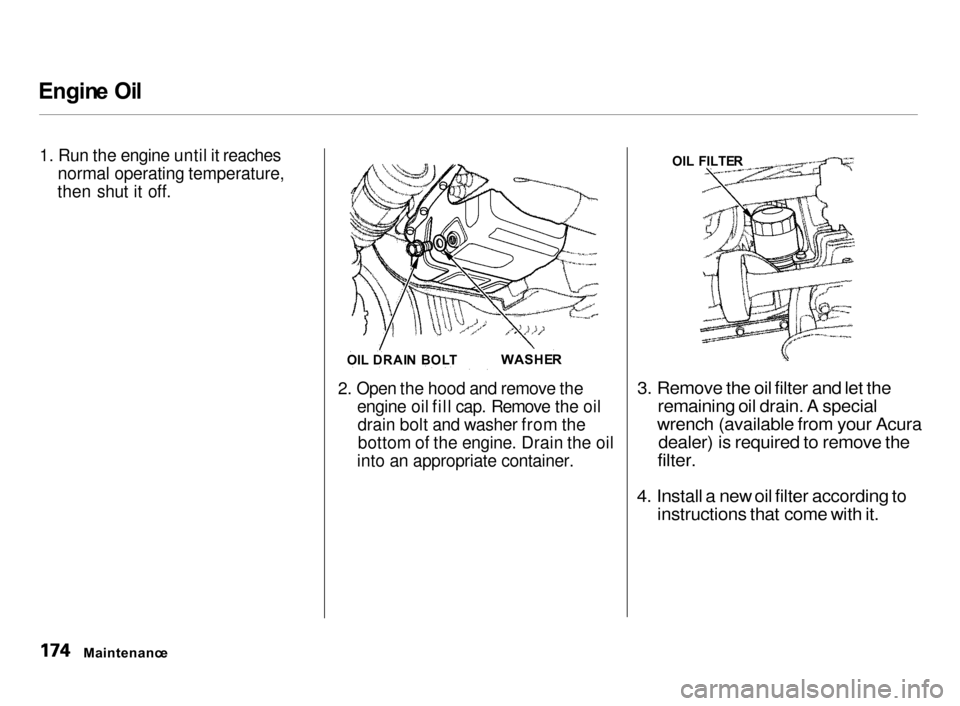
Engin
e Oi l
1. Run the engine until it reaches
normal operating temperature,
then shut it off.
2. Open the hood and remove the
engine oil fill cap. Remove the oil drain bolt and washer from thebottom of the engine. Drain the oil
into an appropriate container.
3. Remove the oil filter and let the
remaining oil drain. A special
wrench (available from your Acura dealer) is required to remove the
filter.
4. Install a new oil filter according to
instructions that come with it.
Maintenanc e
WASHE
R
OI L DRAI N BOL T OI
L FILTE R
Page 178 of 279
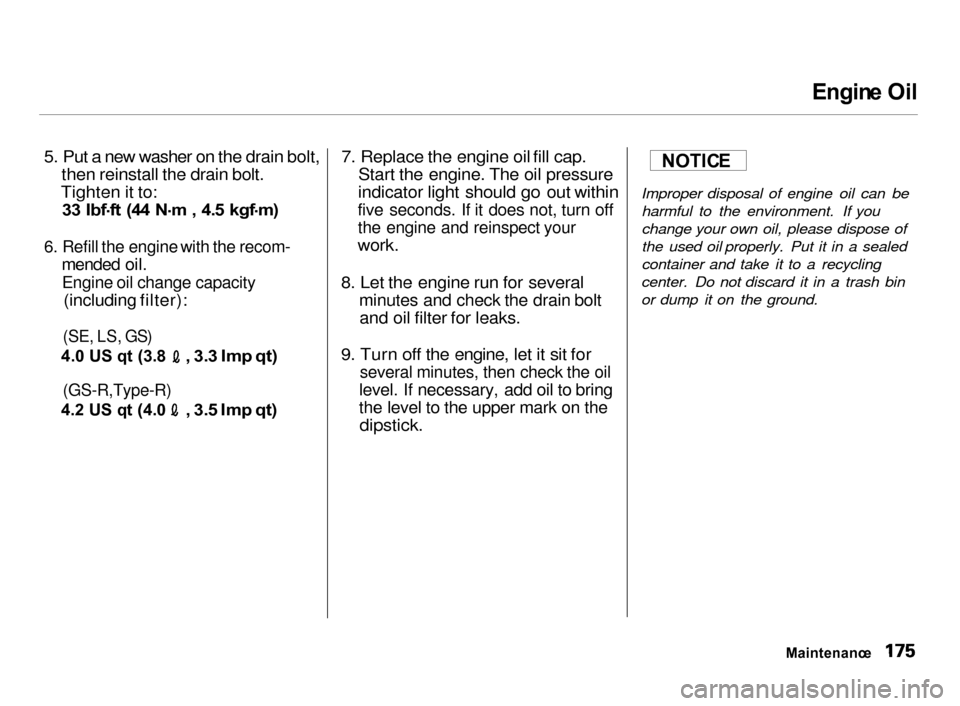
Engin
e Oi l
5. Put a new washer on the drain bolt,
then reinstall the drain bolt.
Tighten it to: 3 3 Ibf .
f t (4 4 N .
m , 4. 5 kgf .
m )
6. Refill the engine with the recom-
mended oil.
Engine oil change capacity
(including filter):
(SE, LS, GS)
4.
0 U S q t (3. 8
, 3.3 Im p qt )
(GS-R,Type-R)
4.
2 U S q t (4. 0
, 3.5 Im p qt ) 7. Replace the engine oil fill cap.
Start the engine. The oil pressure
indicator light should go out within
five seconds. If it does not, turn off
the engine and reinspect your
work.
8. Let the engine run for several
minutes and check the drain bolt
and oil filter for leaks.
9. Turn off the engine, let it sit for
several minutes, then check the oil
level. If necessary, add oil to bring
the level to the upper mark on the
dipstick.
Improper disposal of engine oil can be harmful to the environment. If you
change your own oil, please dispose of
the used oil properly. Put it in a sealed
container and take it to a recycling
center. Do not discard it in a trash bin
or dump it on the ground.
Maintenance
NOTIC
E
Page 179 of 279
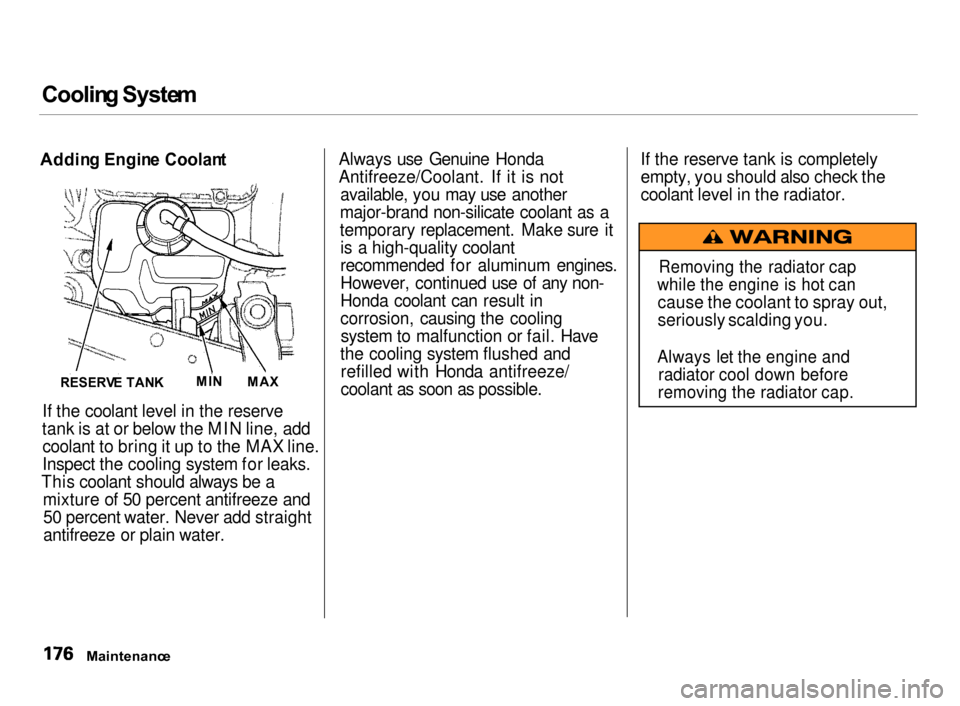
Coolin
g Syste m
Addin g Engin e Coolan t
If the coolant level in the reserve
tank is at or below the MIN line, add coolant to bring it up to the MAX line.
Inspect the cooling system for leaks.
This coolant should always be a mixture of 50 percent antifreeze and50 percent water. Never add straight
antifreeze or plain water. Always use Genuine Honda
Antifreeze/Coolant. If it is not
available, you may use another
major-brand non-silicate coolant as a
temporary replacement. Make sure it is a high-quality coolant
recommended for aluminum engines.
However, continued use of any non-
Honda coolant can result in
corrosion, causing the coolingsystem to malfunction or fail. Have
the cooling system flushed and refilled with Honda antifreeze/
coolant as soon as possible. If the reserve tank is completely
empty, you should also check the
coolant level in the radiator.
Maintenanc e
Removing the radiator cap
while the engine is hot can
cause the coolant to spray out,
seriously scalding you.
Always let the engine and radiator cool down before
removing the radiator cap.
MI
N
MAX
RESERV E TAN K
Page 180 of 279
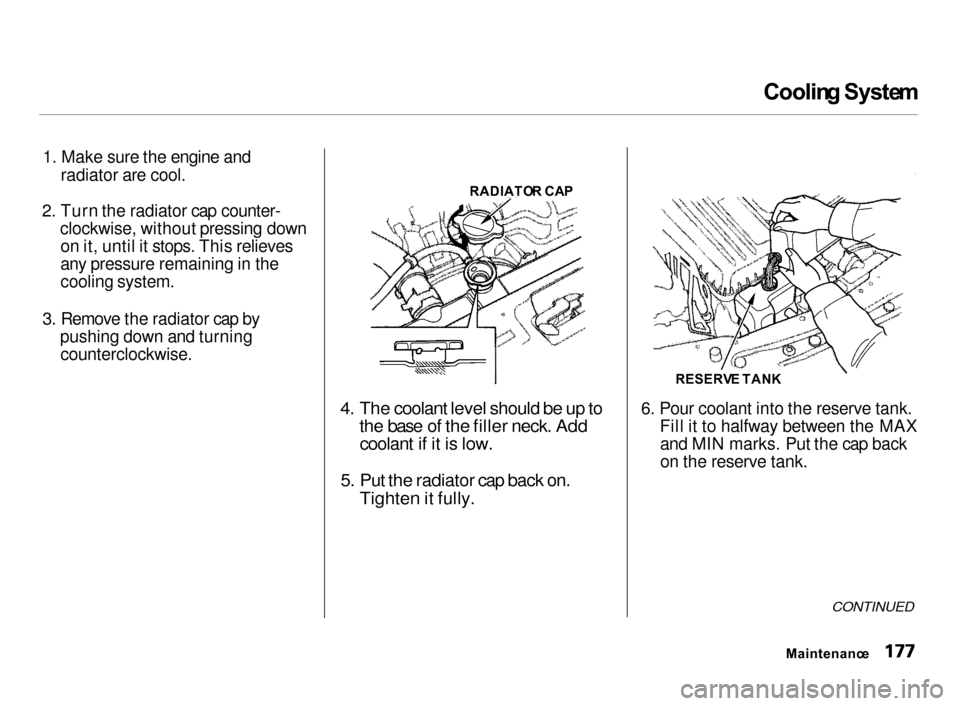
Coolin
g Syste m
1. Make sure the engine and
radiator are cool.
2. Turn the radiator cap counter-
clockwise, without pressing down on it, until it stops. This relieves
any pressure remaining in the
cooling system.
3. Remove the radiator cap by
pushing down and turningcounterclockwise.
4. The coolant level should be up to
the base of the filler neck. Add
coolant if it is low.
5. Put the radiator cap back on.
Tighten it fully.
6. Pour coolant into the reserve tank.
Fill it to halfway between the MAXand MIN marks. Put the cap back
on the reserve tank.
CONTINUED
Maintenanc e
RESERV
E TAN K
RADIATO
R CA P
Page 181 of 279
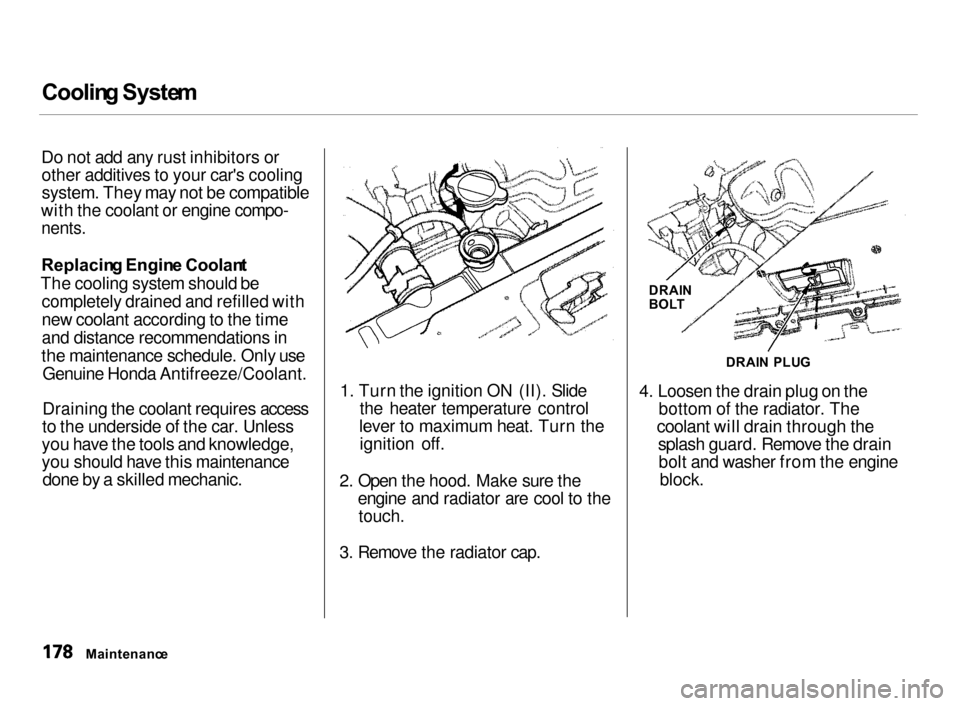
Coolin
g Syste m
Do not add any rust inhibitors or other additives to your car's cooling
system. They may not be compatible
with the coolant or engine compo-
nents.
Replacin g Engin e Coolan t
The cooling system should be completely drained and refilled with
new coolant according to the time
and distance recommendations in
the maintenance schedule. Only use Genuine Honda Antifreeze/Coolant.
Draining the coolant requires access
to the underside of the car. Unless
you have the tools and knowledge,
you should have this maintenance done by a skilled mechanic. 1. Turn the ignition ON (II). Slidethe heater temperature control
lever to maximum heat. Turn the ignition off.
2. Open the hood. Make sure the
engine and radiator are cool to the touch.
3. Remove the radiator cap. 4. Loosen the drain plug on the
bottom of the radiator. The
coolant will drain through the splash guard. Remove the drainbolt and washer from the engine block.
Maintenanc e DRAI
N PLU G
DRAI
N
BOL T
Page 182 of 279
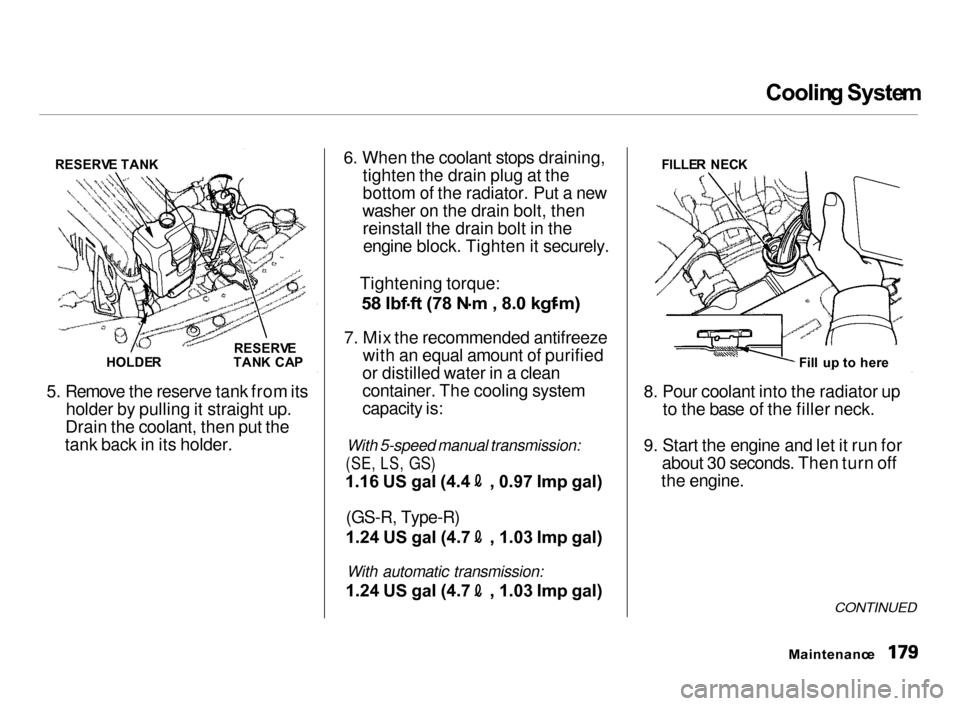
Coolin
g Syste m
5. Remove the reserve tank from itsholder by pulling it straight up.
Drain the coolant, then put the
tank back in its holder.
6. When the coolant stops draining,
tighten the drain plug at the
bottom of the radiator. Put a new
washer on the drain bolt, then reinstall the drain bolt in theengine block. Tighten it securely.
Tightening torque:
58 Ibf .
ft (78 N .
m , 8.0 kgf .
m)
7. Mix the recommended antifreeze
with an equal amount of purified
or distilled water in a clean
container. The cooling system
capacity is:
With 5-speed manual transmission:
(SE,
LS,
GS)
1.16 US gal (4.4 , 0.97 Imp gal)
(GS-R, Type-R)
1.24 US gal (4.7 , 1.03 Imp gal)
With automatic transmission:
1.24 US gal (4.7 , 1.03 Imp gal)
8. Pour coolant into the radiator up
to the base of the filler neck.
9. Start the engine and let it run for
about 30 seconds. Then turn off
the engine.
CONTINUED
Maintenanc e
HOLDE
R RESERV
E
TAN K CA P
RESERV
E TAN K
Fill u p t o her e
FILLE
R NEC K
Page 183 of 279
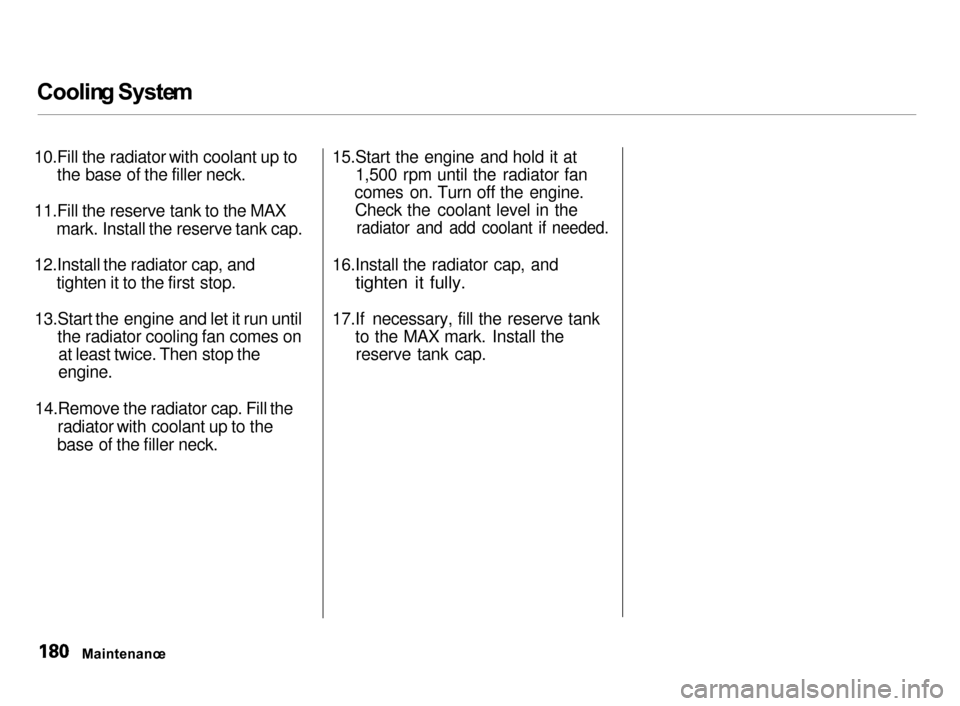
Coolin
g Syste m
10.Fill the radiator with coolant up to
the base of the filler neck.
11.Fill the reserve tank to the MAX
mark. Install the reserve tank cap.
12.Install the radiator cap, and
tighten it to the first stop.
13.Start the engine and let it run until
the radiator cooling fan comes on at least twice. Then stop the
engine.
14.Remove the radiator cap. Fill the
radiator with coolant up to the
base of the filler neck.
15.Start the engine and hold it at
1,500 rpm until the radiator fan
comes on. Turn off the engine. Check the coolant level in the
radiator and add coolant if needed.
16.Install the radiator cap, and
tighten it fully.
17.If necessary, fill the reserve tank
to the MAX mark. Install thereserve tank cap.
Maintenanc e
Page 184 of 279
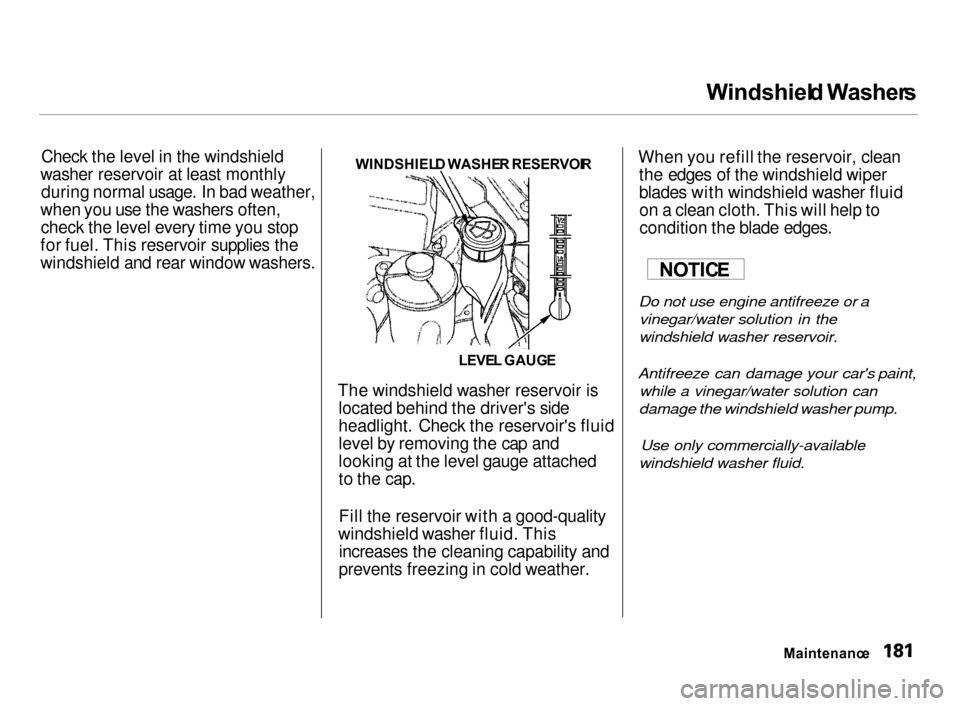
Windshiel
d Washer s
Check the level in the windshield
washer reservoir at least monthly during normal usage. In bad weather,
when you use the washers often, check the level every time you stop
for fuel. This reservoir supplies the
windshield and rear window washers.
The windshield washer reservoir islocated behind the driver's side
headlight. Check the reservoir's fluid
level by removing the cap and
looking at the level gauge attached
to the cap.
Fill the reservoir with a good-quality
windshield washer fluid. This increases the cleaning capability and
prevents freezing in cold weather. When you refill the reservoir, clean
the edges of the windshield wiper
blades with windshield washer fluidon a clean cloth. This will help to
condition the blade edges.
Do not use engine antifreeze or a vinegar/water solution in the
windshield washer reservoir.
Antifreeze can damage your car's paint, while a vinegar/water solution can
damage the windshield washer pump.
Use only commercially-available
windshield washer fluid.
Maintenance
NOTIC
E
WINDSHIEL
D WASHE R RESERVOI R
LEVE L GAUG E
Page 185 of 279
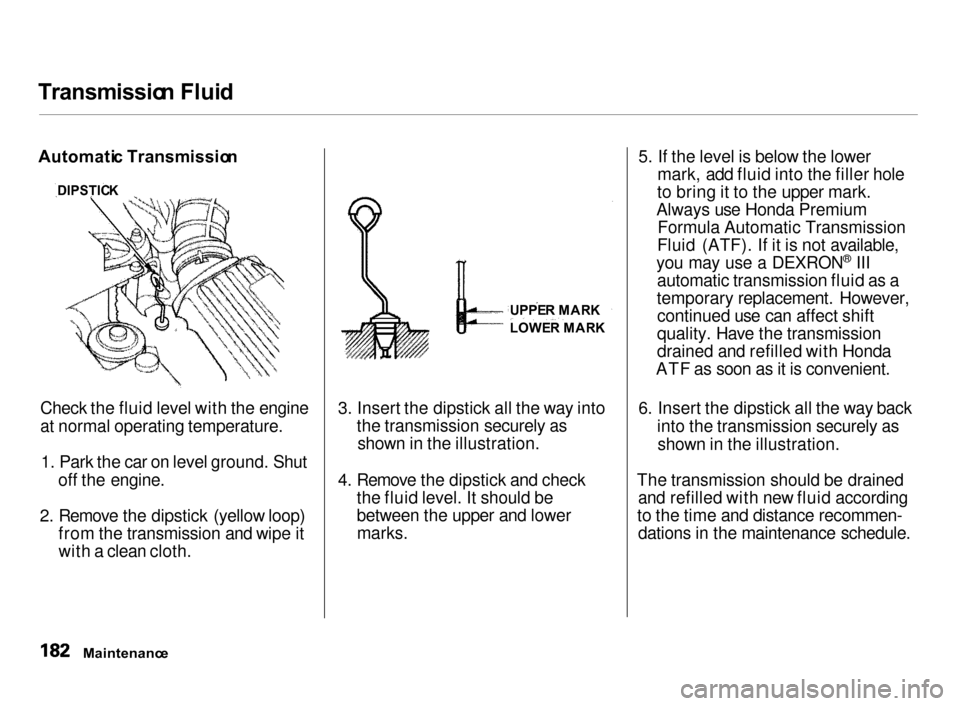
Transmissio
n Flui d
Automati c Transmissio n
Check the fluid level with the engine
at normal operating temperature. 1. Park the car on level ground. Shut
off the engine.
2. Remove the dipstick (yellow loop)
from the transmission and wipe it
with a clean cloth.
3. Insert the dipstick all the way into
the transmission securely asshown in the illustration.
4. Remove the dipstick and check
the fluid level. It should be
between the upper and lowermarks.
5. If the level is below the lower
mark, add fluid into the filler hole
to bring it to the upper mark.
Always use Honda Premium Formula Automatic Transmission
Fluid (ATF). If it is not available,
you may use a DEXRON
® III
automatic transmission fluid as a
temporary replacement. However, continued use can affect shift
quality. Have the transmission
drained and refilled with Honda
ATF as soon as it is convenient.
6. Insert the dipstick all the way back
into the transmission securely as
shown in the illustration.
The transmission should be drained
and refilled with new fluid according
to the time and distance recommen- dations in the maintenance schedule.
Maintenanc e
UPPE
R MAR K
LOWE R MAR K
DIPSTIC
K